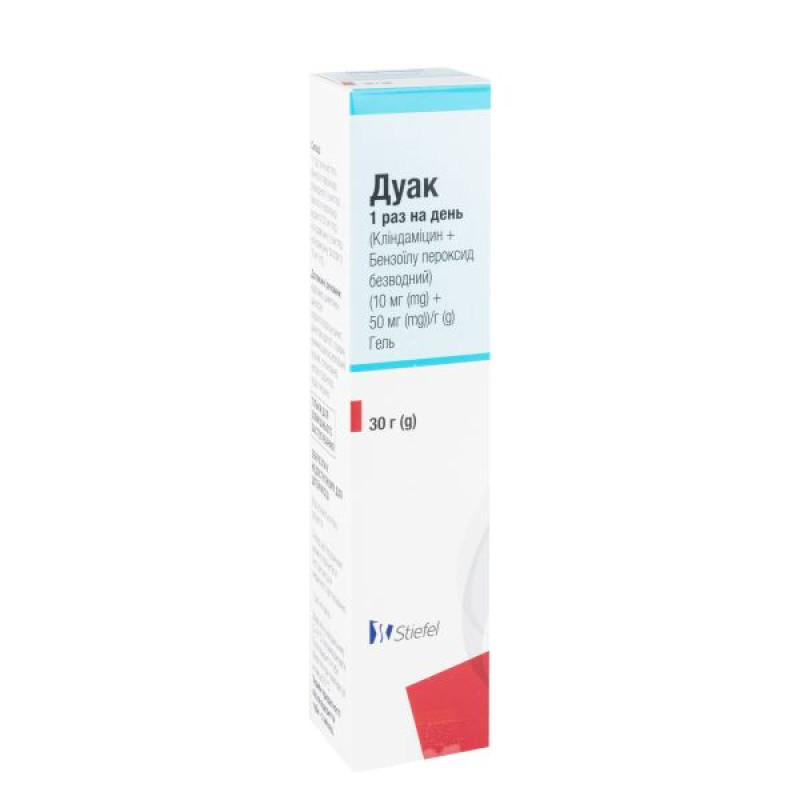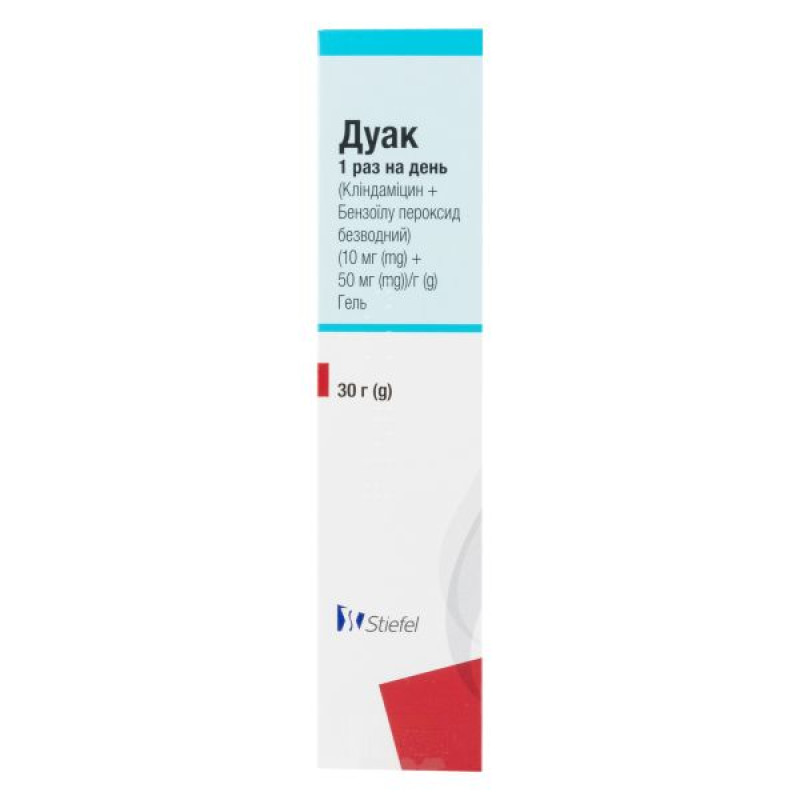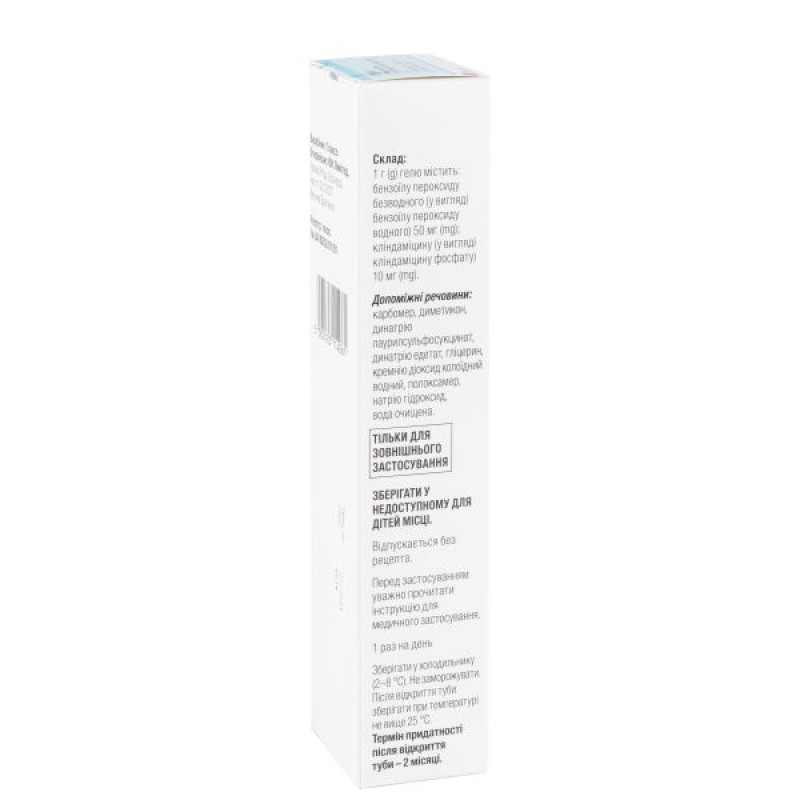Duak gel tube 30 g

Instructions for Duac gel tube 30 g
Warehouse
active ingredients: benzoyl peroxide anhydrous (in the form of benzoyl peroxide aqueous), clindamycin (in the form of clindamycin phosphate);
1 g of gel contains benzoyl peroxide anhydrous (as benzoyl peroxide aqueous) 50 mg; clindamycin (as clindamycin phosphate) 10 mg;
excipients: carbomer, dimethicone, disodium lauryl sulfosuccinate, disodium edetate, glycerin, colloidal silicon dioxide, poloxamer, sodium hydroxide, purified water.
Dosage form
Gel.
Main physicochemical properties: homogeneous gel of white or slightly yellowish color.
Pharmacological group
Topical acne treatments. ATX code D10A F51.
Pharmacological properties
Pharmacodynamics
Clindamycin is a lincosamide antibiotic with bacteriostatic activity against gram-positive aerobic microorganisms and a wide range of anaerobic bacteria. Lincosamides, such as clindamycin, bind to the 23S subunit of the bacterial ribosome and inhibit early stages of protein synthesis. The action of clindamycin is predominantly bacteriostatic, although high concentrations may exert a slow bactericidal effect against susceptible strains.
Although clindamycin phosphate is inactive in vitro, rapid hydrolysis in vivo renders this compound active against bacteria. The antibacterial activity of clindamycin has been demonstrated clinically in the treatment of comedones in patients with acne at levels sufficient to be active against most strains of Propionibacteium acnes. Clindamycin inhibits all Propionibacteium acnes cultures tested in vivo (MIC-0.4 μg/mL). After application of clindamycin, the percentage of free fatty acids on the skin surface decreased from approximately 14 to 2%.
Benzoyl peroxide has a mild keratolytic effect on comedones at all stages of their development. It is an oxidizing agent with bactericidal activity against Propionibacteium acnes, the microorganism responsible for the development of acne vulgaris. In addition, it is a sebostatic agent that counteracts the excessive production of sebum associated with acne.
The addition of benzoyl peroxide reduces the potential for the emergence of microorganisms resistant to clindamycin.
Pharmacokinetics
Percutaneous absorption of clindamycin is minimal. The presence of benzoyl peroxide in the formulation did not affect the percutaneous absorption of clindamycin. Radiolabeling studies have shown that absorption of benzoyl peroxide through the skin is possible only after its conversion to benzoic acid. Benzoic acid is mainly conjugated to form hippuric acid, which is excreted by the kidneys.
Indication
Topical treatment of mild to moderate acne (acne vulgaris), predominantly inflammatory in adults and children aged 12 years and over.
Contraindication
Hypersensitivity to the components of the drug and lincomycin. Local enteritis, ulcerative colitis or antibiotic-associated colitis (including pseudomembranous colitis) or their presence in history. Children under 12 years of age.
Interaction with other medicinal products and other types of interactions
No drug interaction studies have been conducted.
Clindamycin/benzoyl peroxide should not be used in combination with drugs containing erythromycin due to possible antagonism with clindamycin.
Clindamycin has been shown to have neuromuscular blocking properties that may potentiate the effects of other neuromuscular blocking agents. Therefore, clindamycin/benzoyl peroxide should be used with caution in patients being treated with such agents.
Concomitant use of clindamycin/benzoyl peroxide with tretinoin, isotretinoin, and tazarotene should be avoided because benzoyl peroxide may reduce their effectiveness and increase irritation. If combination therapy is necessary, the drugs should be applied at different times of the day (e.g., one in the morning and one in the evening).
Concomitant use of benzoyl peroxide-containing preparations and topical sulfonamide-containing preparations may cause temporary discoloration of the skin and scalp (yellow/orange).
With the combined use of topical antibiotics, medical, regular or abrasive soaps and cosmetics with a drying effect, as well as products with a high concentration of alcohol and/or binding agents, a cumulative irritating effect is possible.
Application features
Avoid contact with eyes, mouth, lips, other mucous membranes or areas with irritated or broken skin. In case of accidental contact, rinse thoroughly with water.
Most patients may experience increased peeling and redness of the skin during the first weeks of treatment. Depending on the severity of these side effects, the patient may be advised to apply a moisturizer, temporarily reduce the frequency of application of clindamycin/benzoyl peroxide, or temporarily discontinue use; however, the effectiveness of application less than once daily has not been proven.
If severe local irritation occurs (e.g., severe erythema, dryness or itching, severe stinging/burning), use of clindamycin/benzoyl peroxide should be discontinued.
Benzoyl peroxide may cause increased sensitivity to sunlight, so the use of ultraviolet lamps should be avoided and exposure to sunlight should be avoided or minimized. If strong sunlight exposure cannot be avoided, the patient should be advised to use sunscreen and protective clothing.
If the patient has sunburn, it should be treated before prescribing clindamycin/benzoyl peroxide.
The product may discolor hair and colored and dyed materials. Avoid contact with hair, fabrics, furniture or carpets.
Pseudomembranous colitis
Pseudomembranous colitis, which may range in severity from mild to life-threatening, has been reported with the use of nearly all antibacterial agents, including clindamycin, and may occur several weeks after discontinuation of therapy. Although this is very unlikely with topical clindamycin/benzoyl peroxide, if a patient develops prolonged and severe diarrhea or abdominal cramps, treatment should be discontinued immediately and further evaluation should be performed, as these symptoms may be suggestive of antibiotic-associated colitis.
Clindamycin resistance
Benzoyl peroxide reduces the potential for the emergence of clindamycin-resistant organisms. However, patients with a history of recent systemic or topical use of clindamycin or erythromycin may harbor antibiotic-resistant strains of Propionibacterium acnes and commensal flora.
Cross-resistance
Cross-resistance between clindamycin and lincomycin has been demonstrated.
Resistance to clindamycin is often associated with induced resistance to erythromycin (see section "Interaction with other medicinal products and other forms of interaction").
Use during pregnancy or breastfeeding
Fertility
There are no data on the effects of topical clindamycin or benzoyl peroxide on human fertility.
Pregnancy
There are no adequate data from the use of the gel in pregnant women. Animal studies on reproductive toxicity and the effects on embryo/fetal development of the gel or benzoyl peroxide have not been conducted separately. There are limited data from the use of clindamycin or benzoyl peroxide alone in pregnant women. Observational data on a limited number of pregnancies when the drug was used in the first trimester indicate no adverse effects of clindamycin on pregnancy or the health of the fetus/newborn.
Animal reproductive toxicity studies with oral and subcutaneous administration of clindamycin revealed no evidence of impaired fertility or harmful effects on the fetus.
The safety of using the gel during pregnancy has not been established.
Therefore, during pregnancy, a doctor can prescribe the drug only if the expected benefit to the woman outweighs the potential risk to the child.
Breast-feeding
No clinical studies have been conducted to study the use of topical clindamycin/benzoyl peroxide during breastfeeding. However, it is known that percutaneous absorption of clindamycin/benzoyl peroxide is low; it is not known whether clindamycin or benzoyl peroxide is excreted in breast milk following topical administration. However, clindamycin has been reported to be present in breast milk following oral and parenteral administration.
Therefore, during breastfeeding, a doctor may prescribe the drug only if the likely benefit to the mother outweighs the potential risk to the child.
To avoid accidental ingestion of Duac gel by infants when used by the mother during lactation, the gel should not be applied to the breast area.
Ability to influence reaction speed when driving vehicles or other mechanisms
No studies have been conducted on this effect. Given the adverse reaction profile of the drug, no negative effects are expected.
Method of administration and doses
For external use only.
Adults and children from 12 years old.
Duac is applied once a day in the evening to the affected areas after thorough cleansing, rinsing the skin with water and drying. If the gel does not rub into the skin easily, this indicates that too much is being applied.
Hands should be washed after applying the gel. The patient may apply moisturizer if necessary.
If excessive dryness or peeling of the skin occurs, the frequency of application should be reduced or the treatment should be temporarily discontinued. The effectiveness of treatment has not been proven when used less than once a day. Apply the gel a little more than once a day.
Patients should be warned that increasing the amount of gel does not increase the effectiveness of the drug, but increases the risk of skin irritation.
It may take 2 to 5 weeks of treatment to achieve a therapeutic effect. The maximum course of treatment is 12 weeks.
Children
Do not use in children under 12 years of age.
Overdose
When benzoyl peroxide is applied topically, it is generally not absorbed in sufficient amounts to have a systemic effect.
Excessive topical application of clindamycin may result in its absorption in quantities sufficient to produce a systemic effect.
In case of accidental oral administration, gastrointestinal adverse reactions similar to those observed with systemic use of clindamycin may occur.
Appropriate symptomatic measures should be taken to reduce symptoms of irritation in case of excessive topical application. In case of accidental internal use, appropriate clinical care should be provided.
Side effects
Adverse reactions are presented in the most general form when using the combination and when using the active substances of the drug - benzoyl peroxide and clindamycin separately. Adverse reactions are presented according to the MedDRA classification and frequency (see table 1). The frequency is defined as follows: very common (≥ 1/10); common (≥ 1/100 and < 1/10); uncommon (≥ 1/1000 and < 1/100); rare (≥ 1/10000 and < 1/1000) and unknown (cannot be estimated from the available data).
Table 1. Adverse reactions when using the active ingredients of the drug – benzoyl peroxide and clindamycin.
| MedDRA system organ class | Very often | Often | Not often | Unknown ** |
| Immune system disorders | Allergic reactions, including hypersensitivity and anaphylaxis | |||
| Nervous system disorders | Paresthesia | |||
| Gastrointestinal disorders | Colitis (including pseudomembranous colitis), haemorrhagic diarrhoea, diarrhoea, abdominal pain | |||
| Skin and subcutaneous tissue disorders* | Erythema, scaling, dryness (mainly reported as moderate intensity events) | Burning sensation | Contact dermatitis, pruritus, erythematous rash, acne exacerbation | Hives |
| General disorders and administration site conditions | Application site reactions, including discoloration |
* At the site of application.
** Based on post-marketing surveillance data. Because these observations involve populations of unknown size and include confounding factors, it is not possible to reliably estimate their frequency, but systemic reactions were rare.
In addition to the adverse reactions listed in the table above, in the pivotal clinical trial with topical clindamycin 1%/benzoyl peroxide 3%, gel, photosensitivity reactions at the application site were commonly observed.
Local portability
In 5 clinical studies with Duac gel, all patients were classified according to the degree of erythema, scaling, burning sensation and dryness according to the following scale: 0 – no symptoms, 1 – mild, 2 – moderate, 3 – severe. The percentage of patients with symptoms before and during treatment is presented in Table 2.
Table 2. Local tolerability of Duac gel when applied once daily in patients (n=397) who participated in a phase 3 clinical study.
| Adverse reactions | Before treatment | During treatment | ||||
| Weak degree | Moderate degree | Severe degree | Weak degree | Moderate degree | Severe degree | |
| Erythema | 28% | 3% | 0 | 26% | 5% | 0 |
| Peeling | 6% | <1% | 0 | 17% | 2% | 0 |
| Burning sensation | 3% | <1% | 0 | 5% | <1% | 0 |
| Dryness | 6% | <1% | 0 | 15% | 1% | 0 |
Expiration date
15 years.
The shelf life after the first opening of the tube is 2 months.
Storage conditions
Keep out of reach of children. Store in a refrigerator (2–8°C). Do not freeze.
Storage conditions after the first opening of the tube.
Store out of the reach of children at a temperature not exceeding 25 °C.
Packaging
15 g or 25 g or 50 g of gel in a tube, 1 tube in a cardboard box.
Vacation category
Without a prescription.
Producer
Glaxo Operations UK Limited, United Kingdom.
Glaxo Operations UK Limited, United Kingdom.
Address
Glaxo Operations UK Limited, Harmere Road, Barnard Castle, DL12 8DT, United Kingdom.
Glaxo Operations UK Limited, Harmire Road, Barnard Castle, DL12 8DT, United Kingdom.
There are no reviews for this product.
There are no reviews for this product, be the first to leave your review.
No questions about this product, be the first and ask your question.








